How to play Chinese Chess for beginners
The way to play Chinese Chess for beginners, Chinese Chess helps people to become in the spirit of fun, civilized entertainment that all ages should play.
Chess has always been a favorite entertainment subject for the Vietnamese seniors with strict rules of the game. Playing chess helps people to become in the spirit of fun, civilized entertainment that all ages should play. If the children play the game of chess to develop thinking, the middle-aged people will get intellectual sanity. Chess originated from China, also known as Chinese Chess, now besides the traditional way of playing chess, we can also play online chess , online chess , etc.
Basic Chinese Chess game for beginners
From the early stone chessboards, to the "sidewalk wonders" or great competitions, Chinese Chess has shown its development right on the computer, iPad, or smartphone. Players can play online, can also practice playing Chinese if they are a beginner, all stemmed from their love and passion for this game.
General introduction to Chinese Chess
Chess table
The chess board is a rectangle assembled from 9 vertical columns and 10 horizontal rows that intersect each other at 90 squares. The middle of the board is divided from each other by a space called the river (or ha).

Types of pieces in chess
Starting a game of chess will have a total of 32 pieces divided into 2 sides against each other. Each side has 16 cards in all with 7 different types of cards: General, Si, Statue, Rook, Cannon, Knight, Pawn. The symbols of each side will be different (written in Chinese characters), but the way of each type will be completely the same. Specifically, the chess piece symbol and the number of each side will look like the table below:
| Symbol | Army name | Amount |
|---|---|---|
 |
Chess | first |
 |
Si | 2 |
 |
Statue | 2 |
 |
Vehicle | 2 |
 |
Cannon | 2 |
 |
Code | 2 |
 |
Good | 5 |
How to move the types of chess pieces
- Heroes : Can only go one square at a time: horizontal or vertical. The General can only move in the Palace, not allowed to go out. "Bow" is a 3 × 3 square shape marked with a diagonal slash like the letter X.
- Si : Soldiers only go diagonally 1 cell per country. Si must always be in the palace like General.
- Statue : For each move, the Bishop can go diagonally 2 squares (horizontal 2 and vertical 2). The statue is only allowed to move on one side of the chessboard, not over the river and to the opponent's board. If there is a chess piece in the middle of the path, the bishop will not be able to move.
- Rook : The Rook can pass either sideways or along the board, as long as no other piece is blocking the way between the origin and destination.
- Code : Go diagonally between a rectangle made up of 2 horizontal cells and 1 vertical cell (or 2 vertical 1 horizontal). If there is a chess piece next to the Ma piece and blocking the way, Ma will be prevented from going that way.
- Cannon : can move horizontally and vertically like the Rook. The difference is that if the cannon wants to grab a piece, the cannon has to jump over exactly one piece.
- Good : Pawns go one slot each time. If the Pawn has not crossed the river, it can only go straight, but once it has reached the opponent's board, the Pawn can either move sideways or advance (1 square).
Basic laws
- Winning : When the piece moves to a position where the enemy piece is standing, the enemy piece will be taken and must be removed from the board.
- Anti-General : When two Generals on the table are on the same vertical column and there is no Stop piece in the middle, it is called Anti-General. Any move to put 2 Heroes in an Anti-General situation is invalid and not allowed.
- Prohibit checkmate continuously 10 times.
Basic Chinese Chess game guide for beginners
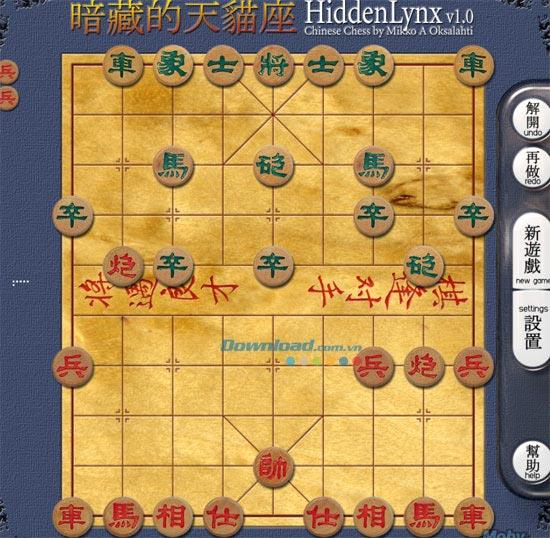
If you love playing chess, but are afraid to study outside and don't know where to start, how to start, then start with the following basics:
- First of all, the new player needs to have a good grasp of the opponent's shape, name, position, movement, blocking moves as well as taking the opponent's pieces, how to discern to lose each match.
- Know how to analyze tactics, see why the opponent made that move, and which pieces should I move, how.
- Understand how effective the combination of chess pieces, chess positions, and chess positions will be.
- Learn the basics of chess, checkmate, checkmate and play strategies when the chess goes down.
Among the above, there are opinions that the number one important thing besides getting the pieces and moving, that is the position, the way to play when the chess goes down. Bad chess means that when the game is played towards the end, both sides have certain losses in terms of numbers and posture. They said that, when the opening of each move is only relative, the following countries will supplement and overcome the mistakes of the previous one, possibly improvising. By the time the game goes down, the danger increases and each opportunity counts as a victory, so the stance, the way to play when the game goes down is most important.
However, there are also opinions that, when starting to use "low" countries, it will lose the advantage and when not able to deploy the game, it will be easy to be overwhelmed, leading to the middle of the game. in the end, and in the end it is hard to endure.
The special point about Chinese Chess, this is not a game that can guide someone to play in a fixed or book, because this is an intellectual game . This means that each player has their own way of playing, their own style of play shows their own style and personality as well as their gameplay. Actually, there are a lot of lessons, documents, books, pictures or even a video tutorial on how to play Chinese Chess, but thought, is that necessary? Once the player has mastered the basics, they can, should, play their own way, because everything at the moment is only for reference, advanced. However, if considered carefully, it is possible to put the following basic moves that players need to understand and understand well:
- Catch (eat) pieces : One of the two players using any of his chess pieces creates intimidation (capable of eating) with other pieces of the opponent. Use in attack, create your own posture.
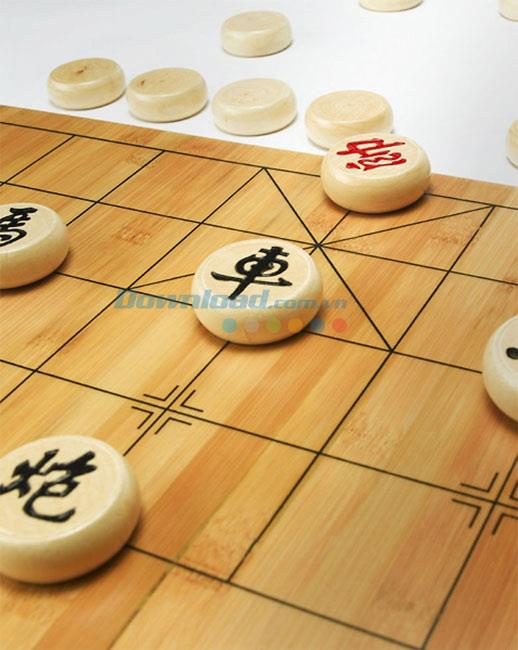
- Stop move : Use your chess piece to prevent the movement or attack of the opponent's chess piece (position). Often used in defense.
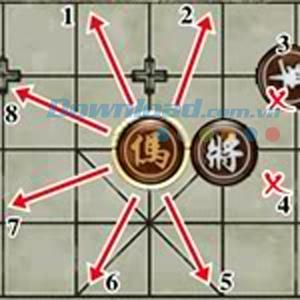
Code cannot move to position 3, 4 due to obstruction
- Match Country: The purpose and outcome of a game is determined only when the Chess of either party is captured (eaten). This move occurs when one of the two players exerts a threat on the opponent's Chess, capable of taking their Chess if the other player fails to defend. This is an extremely effective move to distract or force the opponent to sacrifice another piece for support.
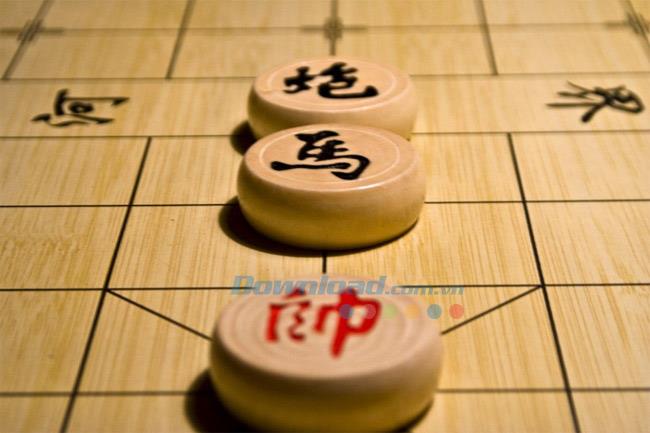
- Counter-check: The move of a person whose General is threatened and forced to move the General to another position, or use another chess piece so that the opponent cannot capture his General in the next country immediately after.
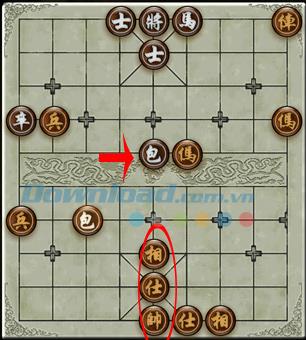
The Guardian (Bishop) covered the General's face to prevent it from being screened
- Checkmate: It is also a broth, but the level and the ability to intimidate, creating a higher danger. Checkmate has the ability to determine more quickly and lose money and the player who is checked is also more difficult to escape.
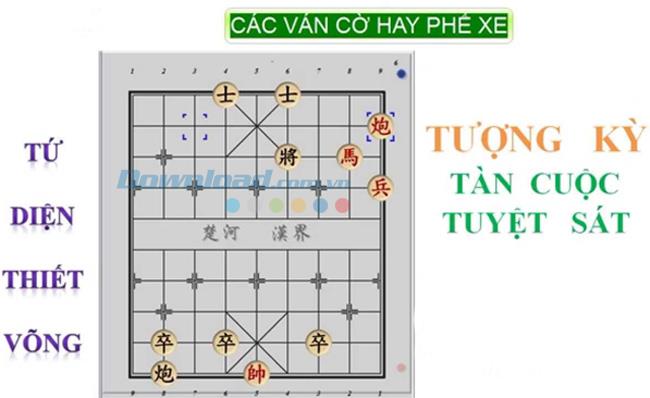
- Trade-offs: This is a trade-off that many people think are quite negative. Players on both sides let each other eat their pieces (equal, or different in strength), thereby clearing the game or changing the position of the pieces to make the next move. There are games that trade the same chess pieces in value and quantity. There are also games that trade one piece for another 2 or 3 of the opponent's pieces. Usually used when a chess game wants to break an opponent's defense, or make a purposeful move into the check.
- Pursuit ( manipulation ): A way to use a more mobile, powerful chess piece to follow and chase the opponent's other chess pieces, in order to create annoyance in the opponent's mentality, wait for errors to put that piece in. mysterious, or unable to focus on true purpose.
End of the match
A game of chess ends when it falls into one of the following situations:
- Checkmate : When one side checks the Champion and the opponent cannot make the next move, the checkmate wins.
- Out of moves : If a party gets a turn to go but doesn't have a valid move, that party will lose.
- Draw : After 120 moves on both sides, no pieces are taken.
See more clip about Chess Introduction:
Some Chinese Chess games on PC and mobile
- ZingPlay Chinese Chess (Online)
- Chinese Chess for Android
- ZingPlay - Chinese Chess - Chinese Chess for Android
- Chinese Chess for iOS
- Vietnamese Chinese Chess for iOS
The above are some of the most basic and important moves for new players to understand and get acquainted with Chess . There are still many other basics about this subject that Download.vn will guide you gradually in the following articles.
Wish you have fun and entertaining moments!